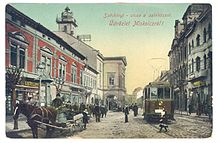Transport in Hungary relies on several main modes, including transport by road, rail, air and water.

Miskolc is a city in northeastern Hungary, known for its heavy industry. With a population of 161,265 as of 1 January 2014, Miskolc is the fourth largest city in Hungary. It is also the county capital of Borsod-Abaúj-Zemplén and the regional centre of Northern Hungary.
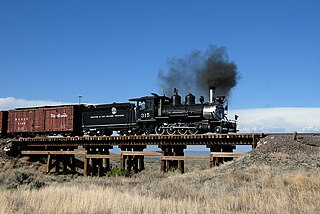
Conservation and restoration of rail vehicles aims to preserve historic rail vehicles.

Heritage streetcars or heritage trams are a part of the efforts to preserve rail transit heritage. In addition to preserving street-running rail vehicles, heritage streetcar operations can include upkeep of historic rail infrastructure. Working heritage streetcars are closely related to the growing global heritage railway movement and form a part of the living history of rail transport.

Miskolctapolca or Miskolc-Tapolca is a suburb of Miskolc, and is one of the most popular tourist towns of Hungary. Not to be confused with Tapolca town in Veszprém County.
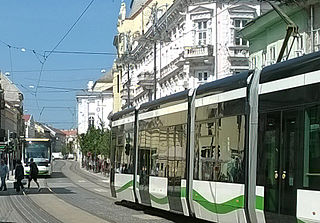
MVK Zrt. is the name of the transport company of the city of Miskolc, Hungary. Unlike the transport companies of many other cities, MVK Zrt. is independent from the company responsible for municipal transport in the county (Volánbusz) and is responsible only for the mass transportation in Miskolc and the nearby town Felsőzsolca. The buses are usually dark blue; the trams on Line 1 are yellow or red, on Line 2 are dark red. Miskolc has recently invested much in its public transportation. By the year 2016 90% of the company's vehicles will be low-floor.

BHÉV is a system of four commuter rail lines and rapid transit lines in and around Budapest, Hungary. The BHÉV operates on standard gauge, and is electrified at 1100 V DC.
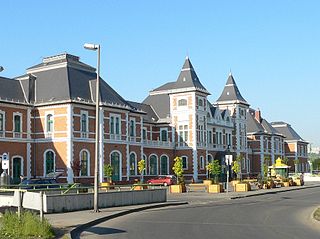
The Tiszai Railway Station, operated by Hungarian State Railways, is the larger of two railway stations of the city of Miskolc, Hungary. Despite its name, the station is not close to the river Tisza; it was named after the company that built it.
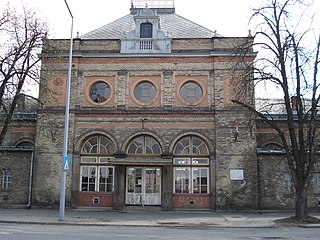
Miskolc–Gömöri railway station, operated by Hungarian State Railways, is the smaller of two railway stations of the city of Miskolc, Hungary.

Miskolc City Centre is basically the historical part of the city of Miskolc, Hungary. Most of the other parts of the city were either independent towns and villages previously, or they were built later.

Public transport in Debrecen, Hungary, is provided by DKV
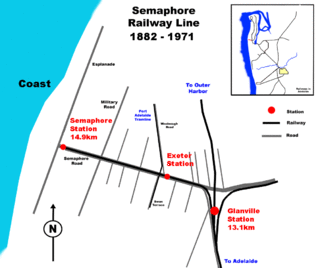
Semaphore railway line was a railway line in the Australian state of South Australia located in the north-west of Adelaide servicing the suburbs of Semaphore and Exeter. It had two stations: Semaphore and Exeter. The line opened in 1878 and closed in 1978.

The Istanbul nostalgic tramways are two heritage tramlines in the city of Istanbul, Turkey. The city has two completely separate heritage tram systems, one on the European side, the other on the Asian side.
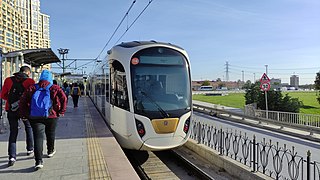
The Istanbul Tram is a modern tram system on the European side of Istanbul. The first section, the T1 opened in 1992, followed by the T2, which opened in 2006. In 2011, the T1 and T2 merged, with the line retaining the T1 name. The T4 and the T5 lines followed, opening in 2007 and 2021, respectively.
Christchurch tramway routes have developed from lines that were first established by a troika of private tramway companies in the latter part of the 19th century, through to a significantly expanded system under the municipal Christchurch Tramway Board, to the City Council-built heritage circuit. These routes have been worked by all three main forms of tramway motive power and have significantly contributed to the development of Christchurch City in New Zealand's South Island.

The Bonn tramway network forms part of the public transport system in the city Bonn, North Rhine-Westphalia, Germany, along with the Bonn Stadtbahn with which the tramlines are heavily integrated. The tram network consists of three tram lines which makes Bonn's tramway relatively small, as it comprises only 29.52 kilometres (18.34 mi) of route. The tramway is operated by 24 low-floor tramcars.

Trams in Debrecen is an important part of the public transport network serving Debrecen, Hungary. In operation since 1911, the network presently has two lines.

Trams in Szeged are an important part of the public transport network serving Szeged, Hungary.
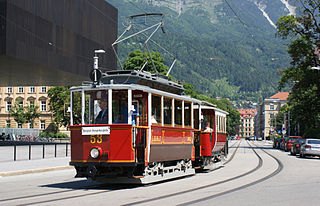
The Innsbruck tram network is currently organised over six routes and has a total length of 44 kilometres (27 mi).
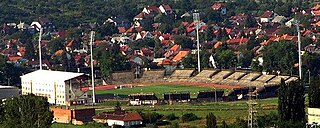
Diósgyőri Stadion was a multi-purpose stadium in Miskolc, Hungary. It was the playing field of the local football association and was the home of the Diósgyőri VTK. It had a capacity of approximately 17,000.


